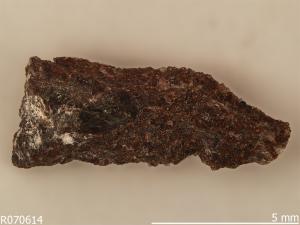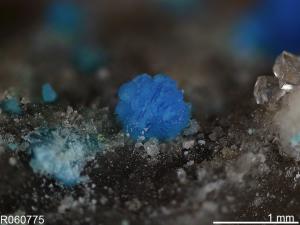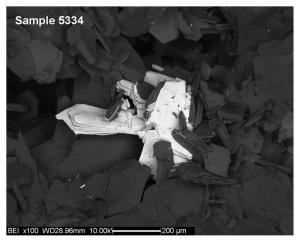For a special Valentine? Beyond Diamonds and Gems: The World's Rarest Minerals

Fingerite, the "perfect storm of rarity" forms under rare conditions (category 1), from rare elements (cat. 2), is water soluble / disappears in rain (cat. 3), and found near an active volcano, so rarely collected (category 4). Pic: http://bit.ly/1PzFBw
What do 2,500+ obscure, isolated mineral species reveal about Earth?
These 2,550 minerals are far more rare than pricey diamonds and gems usually presented as tokens of love. But while their rarity would logically make them the most precious of minerals, many would not work in a Valentine's Day ring setting. Several are prone to melt, evaporate or dehydrate. And a few, vampire-like, gradually decompose on exposure to sunlight.
Their greatest value to humanity lies in the tell-tale clues they offer about the sub-surface conditions and elements that created them, as well as insights into the planet's past biological upheavals. In fact, rare minerals represent Earth's truest distinction from all other planets, according to authors of a paper in press to appear in the journal American Mineralogist.
Scientists Robert Hazen of the Carnegie Institution and Jesse Ausubel of The Rockefeller University say that knowing fully the mineral signature of our life-supporting planet -- understanding the distinct combinations of circumstances that create rare minerals -- also informs anticipation of what an inter-planetary probe might find.
Their paper, "On the Nature and Significance of Rarity in Mineralogy," establishes the first system for categorizing rarities in the mineral kingdom and provides mineralogists a framework that parallels one used for understanding rare plant and animal species.
The authors note the irony that precious gems and other minerals highly valued by humankind -- including so-called "rare earth" minerals required to make electronics -- don't meet the definition of rare as far as Planet Earth is concerned.
Says the paper: "Diamond, ruby, emerald, and other precious gems are found at numerous localities and are sold in commercial quantities, and thus are not rare in the sense used in this contribution. Uses of the word 'rare' in the context of 'rare earth elements' or 'rare metals' are similarly misleading, as many thousands of tons of these commodities are produced annually."
On the other hand, notes Dr. Hazen, the mineral ichnusaite (high-res image, http://bit.ly/1NUniMX), exemplifies a true rarity -- created through a subterranean mash-up of the radioactive element thorium and lead-like molybdenum, with only one specimen ever found, in Sardinia a few years ago.
"If you wanted to give your fiancé a really rare ring, forget diamond. Give her Sardinian ichnusaite."
Fewer than 100 of 5,090 known minerals make up 99% of Earth's crust
There are 5,090 known, formally recognized mineral species (see endnotes), fewer than 100 of which make up 99% of Earth's crust, with a handful of feldspar species comprising about 60%.
Of those 5,090, roughly 2,550 are defined as rare -- found at five or fewer locations worldwide. And, according to the paper, more than two-thirds of known mineral species, "including the great majority of rare species, have been attributed to biological changes in Earth's near-surface environment."
"We need to re-think 'animal, vegetable, or mineral'," says Prof. Ausubel. "In the old parlor game, if it isn't alive, doesn't grow and comes from the ground, it's a mineral, but some of these rare minerals do grow and don't entirely come from the ground."
Each rare mineral (a selection of 99 examples is available at http://bit.ly/1KlU6U4) fits into one or more of four categories:
1) Unique conditions that created the mineral
Amicite is a category 1 rarity: formed from very common elements, but requiring extremely precise conditions of temperature, pressure, and composition to form. It's only known from 2 localities. Named for 19th century French physicist Giovanni Battista Amici (1786-1863). High-res: http://bit.ly/1TDityG
"In very simple terms, imagine making minerals at a kitchen stove using a pressure cooker," says Dr. Hazen. "What results in the pot is a function of variables: temperature, pressure and the ingredients -- one or more of just 72 chemical elements that make up Earth's mineral kingdom."
"Some minerals are rare because, even though they form from the commonest of ingredients, they must be cooked at exquisitely controlled conditions. For example, the mineral hatrurite, (http://www.mindat.org/min-1828.html) is formed from three of Earth's most abundant elements--calcium, silicon, and oxygen. But hatrurite forms only in a very restricted environment with temperatures above 1250°C -- many times hotter than the boiling point of water -- and in the absence of another extremely common element, aluminum."
By knowing the idiosyncratic combination of circumstances involved in a rare mineral's creation, scientists can deduce what elements are or aren't present at a specific depth, and in some cases such information as acidity at that level below surface.
2) Planetary constraints: Incorporation of rare elements, or mineral formation at pressure-temperature conditions rarely encountered in near-surface environments
Other minerals are extremely rare because their ingredients are almost never found concentrated in Earth's crust. Thus, such scarce chemical elements as beryllium, hafnium and tellurium form relatively few minerals and most species are rare.
3) Ephemeral minerals
Some minerals form under unusual conditions--extreme cold or dry environments, for example--but then simply melt, evaporate or dehydrate when exposed to different surface conditions.
A crystalline form of methane hydrate, for example, found in core samples from continental shelf and Arctic drill sites, evaporates at room pressure.
As well, "water-soluble minerals may also be under-reported, and thus appear to be rare," the paper says. More than 100 mineral species can persist in dry environments for many years, "only to be washed away during rare rain events."
Among the least stable are rare mineral species that adsorb moisture from the air then dissolve in it. And a few, like edoylerite (http://www.mindat.org/min-1354.html), Metasideronatrite (mindat.org/gm/2685) and Sideronatrite (http://www.mindat.org/min-3650.html) gradually decompose on exposure to sunlight.
4) Places geologists rarely sample
In the fourth category are rare minerals that simply come from under-sampled regions, from extreme environments such as the flanks of erupting volcanoes, frigid and remote regions of Antarctica, or the deepest reaches of the oceans.
The full text of this release continues here: http://bit.ly/1mvwIZ8. All pics credit Robert Downs, University of Nevada
Terry Collins
American Mineralogist
+14168788712
email us here
Legal Disclaimer:
EIN Presswire provides this news content "as is" without warranty of any kind. We do not accept any responsibility or liability for the accuracy, content, images, videos, licenses, completeness, legality, or reliability of the information contained in this article. If you have any complaints or copyright issues related to this article, kindly contact the author above.


